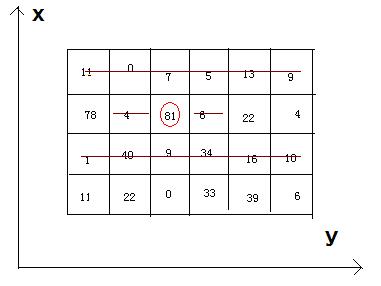吃土豆
时间限制:1000 ms | 内存限制:65535 KB
难度:4
- 描述
- Bean-eating is an interesting game, everyone owns an M*N matrix, which is filled with different qualities beans. Meantime, there is only one bean in any 1*1 grid. Now you want to
eat the beans and collect the qualities, but everyone must obey by the following rules: if you eat the bean at the coordinate(x, y), you can’t eat the beans anyway at the coordinates listed (if exiting): (x, y-1), (x, y+1), and the both rows whose abscissas
are x-1 and x+1.
Now, how much qualities can you eat and then get ?- 输入
- There are a few cases. In each case, there are two integer M (row number) and N (column number). The next M lines each contain N integers, representing the qualities of the beans. We can make sure that the quality of bean
isn't beyond 1000, and 1<=M,N<=500.
- 输出
- For each case, you just output the MAX qualities you can eat and then get.
- 样例输入
-
4 6 11 0 7 5 13 9 78 4 81 6 22 4 1 40 9 34 16 10 11 22 0 33 39 6
- 样例输出
-
242
二次dp,
1.首先单独对每行的数据进行DP处理,得到一个最大值;
2,.每行的最大值又组成一个新的数组,再次dp求最大值
#define N 505
#include<stdio.h>
#include<string.h>
#include<stdlib.h>
int MAX(int x,int y){
return x>y?x:y;
}
int main()
{
int m,n,i,j,k,max,a[N][N],dp[N][2],f[N];
while(scanf("%d%d",&m,&n)!=EOF){
for(i=0;i<m;i++)
for(j=0;j<n;j++)
scanf("%d",&a[i][j]);
for(i=0;i<m;i++) {
dp[0][0]=0; dp[0][1]=a[i][0];
for(j=1;j<n;j++){
dp[j][0] = MAX(dp[j-1][0],dp[j-1][1]);
dp[j][1] = dp[j-1][0] + a[i][j];
}
f[i] = MAX(dp[n-1][0],dp[n-1][1]);
}
dp[0][0] = 0; dp[0][1] = f[0];
for(j=1;j<m;j++){
dp[j][0] = MAX(dp[j-1][0],dp[j-1][1]);
dp[j][1] = dp[j-1][0] + f[j];
}
printf("%d\n",MAX(dp[m-1][0],dp[m-1][1]));
}
return 0;
} HDU 题目
Beans
Time Limit: 2000/1000 MS (Java/Others) Memory Limit: 32768/32768 K (Java/Others)Total Submission(s): 2144 Accepted Submission(s): 1081
Problem Description
Bean-eating is an interesting game, everyone owns an M*N matrix, which is filled with different qualities beans. Meantime, there is only one bean in any 1*1 grid. Now you want to eat the beans and collect the qualities, but everyone must obey by the following
rules: if you eat the bean at the coordinate(x, y), you can’t eat the beans anyway at the coordinates listed (if exiting): (x, y-1), (x, y+1), and the both rows whose abscissas are x-1 and x+1.

Now, how much qualities can you eat and then get ?

Now, how much qualities can you eat and then get ?
Input
There are a few cases. In each case, there are two integer M (row number) and N (column number). The next M lines each contain N integers, representing the qualities of the beans. We can make sure that the quality of bean isn't beyond 1000, and 1<=M*N<=200000.
Output
For each case, you just output the MAX qualities you can eat and then get.
Sample Input
4 6 11 0 7 5 13 9 78 4 81 6 22 4 1 40 9 34 16 10 11 22 0 33 39 6
Sample Output
242
改进代码:
#define N 200005
#include<stdio.h>
#include<string.h>
#include<stdlib.h>
int MAX(int x,int y){
return x>y?x:y;
}
int a[N],dp[N][2],f[N];
int main()
{
int m,n,i,j,k,max;
while(scanf("%d%d",&m,&n)!=EOF){
for(i=0;i<m;i++) {
for(j=0;j<n;j++)
scanf("%d",&a[j]);
dp[0][0]=0; dp[0][1]=a[0];
for(j=1;j<n;j++){
dp[j][0] = MAX(dp[j-1][0],dp[j-1][1]);
dp[j][1] = dp[j-1][0] + a[j];
}
f[i] = MAX(dp[n-1][0],dp[n-1][1]);
}
dp[0][0] = 0; dp[0][1] = f[0];
for(j=1;j<m;j++){
dp[j][0] = MAX(dp[j-1][0],dp[j-1][1]);
dp[j][1] = dp[j-1][0] + f[j];
}
printf("%d\n",MAX(dp[m-1][0],dp[m-1][1]));
}
return 0;
}